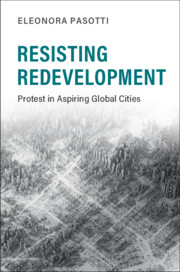Book contents
- Resisting Redevelopment
- Cambridge Studies in Contentious Politics
- Resisting Redevelopment
- Copyright page
- Dedication
- Contents
- Illustrations
- Acknowledgments
- Part I Setting the Comparison
- Part II Explaining Mobilization
- Part III Explaining Impact
- 9 Council Allies and Partisan Alignments
- 10 Shaping Redevelopment in Public Housing Estates
- 11 Militancy with a Twist
- 12 Conclusion
- Book part
- Bibliography
- Index
- Cambridge Studies in Contentious Politics
11 - Militancy with a Twist
Fighting Art to Deter Displacement in Boyle Heights, Los Angeles
from Part III - Explaining Impact
Published online by Cambridge University Press: 09 March 2020
- Resisting Redevelopment
- Cambridge Studies in Contentious Politics
- Resisting Redevelopment
- Copyright page
- Dedication
- Contents
- Illustrations
- Acknowledgments
- Part I Setting the Comparison
- Part II Explaining Mobilization
- Part III Explaining Impact
- 9 Council Allies and Partisan Alignments
- 10 Shaping Redevelopment in Public Housing Estates
- 11 Militancy with a Twist
- 12 Conclusion
- Book part
- Bibliography
- Index
- Cambridge Studies in Contentious Politics
Summary
Chapter 11 examines Union de Vecinos, a group in the Boyle Heights neighborhood of Los Angeles that deployed a radical approach to fighting displacement: It directed its militant protest directly at art galleries, identified as the key culprits of gentrification. Alarmed by the negative publicity and the increasing inability to conduct normal business, gallery directors reached out to residents and activist groups. But the response was defiant, and in response some galleries closed. While the group had some success, it is too early to assess the overall impact of the strategy. Yet the approach merits examination because it is an innovative, ambitious, and analytically coherent response to the threat of displacement. The campaign questioned the role of cultural producers and experiential tools as it called for a radical approach to artistic practice, able to counter art's ties to a capitalist market. It also contributed to the debate on resistance against gentrification because of its harsh critique of the nonprofit sector, judged to be exceedingly accommodating and moderate in its demands.
Keywords
- Type
- Chapter
- Information
- Resisting RedevelopmentProtest in Aspiring Global Cities, pp. 301 - 323Publisher: Cambridge University PressPrint publication year: 2020

